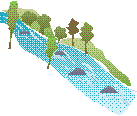WATER MOVES
Background reading
Water, in its many forms, moves all over the Earth. Water vapor moves with the air currents, falling as rain from the clouds. Frozen glaciers creep slowly down from polar regions, then recede as they warm and melt. Liquid water moves from rushing rivers to ocean currents or to groundwater.
The flow of inland freshwater is determined by many factors, including:
- the width and depth of the body of water
- the slope of the land
- the texture of the bottom
- and regional climate.
Ocean waters generally move from the warm area around the equator away towards the poles, causing currents.
|
 Running Water Running Water
Streams and rivers are examples of running waters. Stream water usually comes from groundwater or underground springs and from runoff caused by rain or melting snow. During rainy seasons, ephemeral streams that last for only brief periods are primarily fed by surface runoff. Stream flow is the volume rate of flow of water past a specific point in a stream, usually measured in cubic feet per second (cfs). This measurement is used to compute the loading, or total volume of solids carried in a stream. |
 Still Water Still Water
Lakes and reservoirs are examples of non-moving waters, or rather, less fast moving water. Even lakes and reservoirs have places where water enters and exits.
Most lakes formed naturally thousands of years ago as glaciers gouged depressions in the landscape, which later filled with water. Humans have also created lakes and reservoirs by building dams in rivers or widening stream channels. Most man-made lakes are shallow and were created for human use.
What does it matter? The rate of flow of a water body affects its physical characteristics, and therefore the amount and type of life it can support. For example, a rushing stream will have a higher dissolved oxygen level than a still pond. There are two reasons for this. Still water in a pond absorbs more heat from the Sun and is warmer than running water, so it holds less dissolved gases. Also, moving water has a greater air surface interface because of ripples and splashes, so more gas enters the water from the air. |
 Running Water
Running Water Still Water
Still Water